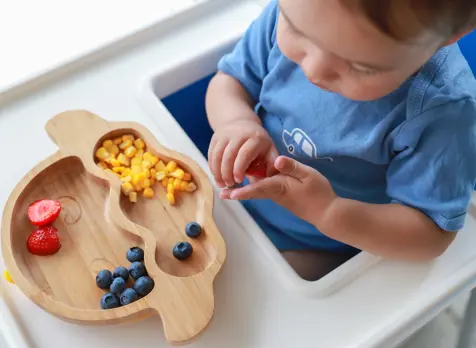Feeding your baby infant formula should be an enjoyable experience for you and your baby. A comfortable chair in a quiet place will help you relax and focus on your baby. Hold your baby so they can easily gain eye contact with you. Unwrap their arms so they can touch and explore while feeding. Gently talk and sing to your baby.
As you offer the bottle to your baby, be aware of the subtle and potent cues they are providing you (see Chapter 5). You may need to stop and change their position during the feed, provide a short break to burp or soothe if they become restless or upset.
If you have twins or triplets, whenever possible feed them one at a time. This provides some important individual time. Often when you are feeding them together, you are not always holding them but the bottles instead. This is especially so as they grow.
Equipment needed
- Bottle with expressed breastmilk or infant milk formula
- Teat held firmly in place by the collar of the bottle
- A container with warm water to heat bottle (if you have other young children remember to keep out of their reach)
- Bib or cloth to wipe your baby’s mouth
How to bottle-feed your baby
- Ensure your baby is comfortable prior to the feed, e.g. nappy change. Unwrap your baby if possible so their hands are free to move.
- Wash your hands.
- Take feeding equipment to where you will feed your baby.
- Check temperature and flow of milk by dropping a little on the inner aspect of your wrist.
- Sit in a comfortable position holding your baby in the crook of your arm, placing the bib under their chin.
- Note the time when feeding begins – aim for between 20 to 30 minutes.
- If you put the teat to your baby’s lips they will usually open their mouth.
- To prevent your baby sucking in air, hold the bottle at an angle, ensuring the teat and neck of bottle contain milk.
- Ensure the teat is above the tongue, and far enough back into mouth to enable the infant to suck in a coordinated manner.
- Some babies improve their suck if their lower jaw is supported by placing two fingers gently under their chin.
- Feeding time is an opportunity to enhance your relationship with your baby, so it is important that you encourage eye contact.
- Observe your baby’s cues or approximately half way through the feed pause, sit your baby up, and help them to bring up wind by gently rubbing their back.
- Alternate the side you are holding your baby from right to left during the feed (as you would if breastfeeding) as this will help promote your baby’s development and allow them to see you from both directions.
- Most babies like to be quietly spoken to during the feed.
- If your baby falls asleep during the feed and you do not think they have had enough milk, unwrap them and spend some time gently waking them by sitting them up (See Chapter 5 on ‘quiet alert’ stage).
Things ‘not’ to do during a feed
- Using a microwave oven to heat your baby’s bottles can be dangerous and is not recommended. The milk heats in an uneven way and presents the risk of severe burns to your baby’s mouth or throat.
- Do not force your baby to feed by constantly jiggling their chin or squeezing their cheeks.
- Do not prolong feeds – preferably no longer than 40 minutes. If your baby becomes distressed or falls asleep after this time, cease the feed.
- Do not prop feed your baby by leaving unattended with their bottle propped on a rolled up towel or pillow. Milk can flow into your baby’s ear canals and can cause an ear infection or the baby may inhale or choke on the milk.
- Do not leave your sleeping baby with a bottle in their mouth. The milk that is pooled in their mouth may cause tooth decay and recurrent ear infections.
Finishing the Feed
Disassemble and wash the bottle and teat in cold water as soon as possible after finishing the feed.
Transporting Prepared Feeds
The safest way to transport infant formula is to take the premeasured cooled, boiled water and the powdered formula in separate containers and mix them when needed. Warm the milk by placing the bottle in a container of warm water. Once the milk is warm, add the powder to the milk, replace the bottle top and collar before shaking the bottle until the infant formula powder is well mixed with the water.
If you need to transport prepared formula or expressed breastmilk, it must be icy cold (5°C) when you leave the house. Carry it in a thermal cool bag with a cooling brick to keep it cold. You must use the feed within two hours if you’re unable to refrigerate the bottle. If able to refrigerate the bottle within the two hours’ travel time it can be stored for 24 hours from preparation time.
Feeding Cups
Feeding cups have come a long way in the last few years and these days there are many different brands available in all sorts of colours and styles. When you’re choosing a feeding cup for your baby, look out for one that:
- Has a tight fitting lid not easily removed by your baby.
- Has two easy to grasp handles for small hands. Your baby will very quickly want to hold the cup.
- Is easy to clean without decorations that can trap milk – this makes cleaning difficult.
- Does not have any sharp edges.
- Is made from a safe form of plastic – it is now possible to buy bisphenol A (BPA) free plastic bottles and feeding cups.
- If your baby is learning to use a spout lid and cup, start with one that is not spill proof to encourage flow and an incentive to drink. Your baby can then move onto a spill proof one as they get to know how it works.
- Feeding cups should continue to be sterilised until your baby is 12 months old.
Bottle-feeding Problems
Using a bottle to feed your baby is not always as easy as it may seem. It’s not a matter of ‘just put your baby on a bottle’. Some babies prefer to be breastfed and will actively refuse to take milk from a bottle, while other babies will fall asleep during feeds and then wake shortly after the feed wanting more food. Other babies will become agitated and upset, holding out for a familiar breastfeed.
Many bottle feeding problems start to occur when you are weaning the baby onto a bottle because you need to return to the paid workforce or for other reasons such as illness. For babies, sucking from a bottle is a very different type of suck to suckling milk from your breast.
The first thing to do is to try to identify the reason why your baby is refusing the bottle.
Check for these signs:
- Has your baby always had some difficulty taking a bottle and it has become more problematic?
- Is your baby unwell? Do they have a temperature; have they started to vomit or become unsettled more than unusual; is their urine becoming smelly and darker in colour or more concentrated; are their bowel motions different, e.g. very frequent, loose, mucousy, frothy or with spots of blood?
- Does you baby have a sore mouth? Sometimes oral thrush can result in the baby having a very sore mouth. There are also other infectious diseases such as human hand, foot and mouth disease that result in small blisters in the mouth.
- If any of the above feeding issues are of concern, have your baby assessed by your child and family health nurse or doctor.
Once you have eliminated any health problems, there are several things to remember and strategies to try:
- Try not to become anxious. With time, patience and a gentle approach your baby will usually learn to take a bottle or in some instances a feeding cup.
- Find a quiet place to feed with minimal distractions and noise.
- If possible, ask your partner, family member or friend to try to do a feed. If breastfed, babies can smell breastmilk on their mothers and can become distressed when not offered the breast.
- If you do not have anyone in the house who can help for a few
feeds, lay the baby in a comfortable elevated position in a rocker or pram to elevate so the head is raised higher than their shoulders. Feed your baby in this position, holding the bottle and gently touching and talking to them. - Do not force your baby to feed by squeezing their cheeks or forcing their chin up and down. This type of forced sucking can create even more difficult problems to solve.
- Do not leave your baby with the bottle propped. This is very dangerous and can result in inhalation of milk into your baby’s lungs or choking, or long term it may cause dental caries and ear infections.
When Baby Falls Asleep During a Feed
Some babies have a habit of falling asleep without finishing their bottle. This is not a problem unless they are waking and demanding a feed frequently or not gaining weight or are losing weight, or not passing adequate amounts of urine.
Check the following issues:
- Is your baby unwell?
- Are you offering too much milk at each feed?
- Is the infant formula correctly made up, i.e. is it too concentrated or too diluted?
- If on solid foods, try offering the bottle before solid foods
- Is the teat too slow or are the holes blocked?
- Does your baby have a rhythmical suck? If not, it may help to place your fingers under your baby’s chin. This provides a slight resistance to suck against.
- If bottle feeding your baby is becoming more and more difficult, it’s important to talk things over with your child and family health nurse or doctor to ensure your baby has no physical reasons for this behaviour.












































